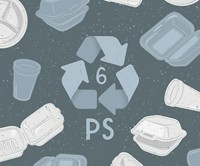Advertisement
Grab your lab coat. Let's get started
Welcome!
Welcome!
Create an account below to get 6 C&EN articles per month, receive newsletters and more - all free.
It seems this is your first time logging in online. Please enter the following information to continue.
As an ACS member you automatically get access to this site. All we need is few more details to create your reading experience.
Not you? Sign in with a different account.
Not you? Sign in with a different account.
ERROR 1
ERROR 1
ERROR 2
ERROR 2
ERROR 2
ERROR 2
ERROR 2
Password and Confirm password must match.
If you have an ACS member number, please enter it here so we can link this account to your membership. (optional)
ERROR 2
ACS values your privacy. By submitting your information, you are gaining access to C&EN and subscribing to our weekly newsletter. We use the information you provide to make your reading experience better, and we will never sell your data to third party members.
Recycling
Promising plastics recycling method relies on simple catalysts
Waste polyethylene and polypropylene can be turned into useful propene and isobutene
by Mark Peplow, special to C&EN
August 30, 2024

A pair of robust and inexpensive catalysts can help recycle mixtures of polyethylene (PE) and polypropylene (PP), two of the most common and intractable types of plastic waste (Science 2024, DOI: 10.1126/science.adq7316). The catalysts chop up the polymers and combine them with ethene to produce propene and isobutene, which can be used to make new plastics.
Although the lab-based process still faces many hurdles before becoming a practical industrial system, it shows how chemical recycling could address some of the most difficult challenges in tackling waste plastic, says John F. Hartwig of the University of California, Berkeley, who led the team.
“This is a pretty big step forward,” says Susannah L. Scott of the University of California, Santa Barbara, who works on similar polymer recycling processes and was not involved in the study. “The fact that they have simple catalysts that could potentially be robust in a realistic process is very important.”
Various forms of PE and PP account for roughly half of global polymer resin production. Their durability makes them incredibly useful but also persistent in the environment, and they are difficult to separate from one another, which poses a major recycling challenge. Pyrolysis can convert PE and PP into oils that feed into industrial crackers, but these high-temperature processes are energy intensive, produce complex mixtures of products, and potentially generate a lot of climate-warming CO2 and methane. Many researchers are instead working on ways to break down polymer chains into their original monomers, but PE and PP have been particularly tough to unpick.
Hartwig’s team has now achieved this using pressurized ethene in conjunction with two catalysts: tungsten oxide on silica and sodium on alumina, both of which are already used in the chemical industry. The process starts with catalytic cracking, which cleaves the polymer into shorter chains containing C=C double bonds. Next, a metathesis reaction with ethene cleaves these double bonds, leaving smaller fragments with terminal C=C groups.
An isomerization reaction then shifts the double bond one position along the chain. Finally, another ethene metathesis reaction slices through the C=C bond, freeing a small molecule from the end—propene from PE or a blend of propene and isobutene from PP. This catalytic isomerization-metathesis cycle repeats over and over again, nibbling away at the polymer chains to release the products.
The reactions run at 320 °C and produce a mix of ethene, propene, and isobutene, which could be teased apart by standard industrial cryogenic separations. It takes about 90 minutes to convert 1 g of mixed plastic with a yield of around 90% and works with real plastic waste such as bread bags, milk jugs, and centrifuge tubes.
But, the sodium catalyst loses about half of its activity with each batch run, and contamination with other polymers such as PET or PVC caused conversion yields to plummet. The researchers now plan further studies to understand exactly how the catalysts are working in the reaction and how the deactivation occurs. “Our high priority right now is to figure out what’s happening with that and how to regenerate it,” Hartwig says. They will also explore other base-metal catalysts that could avoid deactivation and lower the temperature of the process.
Hartwig’s team has previously converted PE into propene using soluble catalysts based on expensive metals such as iridium and palladium, which were fragile and could not handle PP (Science 2022, DOI: 10.1126/science.add1088). At the same time, Scott’s team had independently published a similar method (J. Am. Chem. Soc. 2022, DOI: 10.1021/jacs.2c07781) based on earlier theoretical modeling led by her collaborator Damien Guironnet at the University of Illinois Urbana-Champaign (J. Phys. Chem. A 2020, DOI: 10.1021/acs.jpca.0c01363). “The fact that these catalysts were fragile was a problem because the contaminants in real plastic waste tend to deactivate them very quickly,” Scott says. “This new set of catalysts are likely to be far more compatible with real, dirty, ugly, plastic waste.”
One drawback is that a lot of the carbon contained in the product gases comes from ethene added during the process rather than from the waste polymers. “That means the carbon efficiency is not super,” Scott says. “Figuring out how to do this so that most of the carbon in your product came from the polymers—that would be the next big breakthrough, I think.”





Join the conversation
Contact the reporter
Submit a Letter to the Editor for publication
Engage with us on Twitter